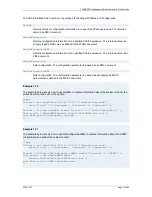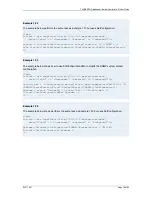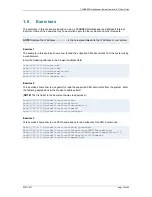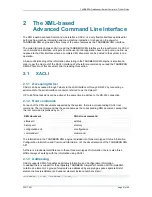
TANDBERG Gatekeeper/Border Controller API User Guide
D14172.01
page 21 of 84
2 The
XML-based
Advanced Command Line Interface
The XML-based Advanced Command Line Interface, XACLI, is a very flexible interface optimized for
both machine-machine interaction and man-machine interaction. It is based on the powerful
TANDBERG XML engine and offers many of the same features as the TANDBERG XML interface.
The main distinction between XACLI and the TANDBERG XML interface is the input format. As XACLI
is a command-line interface, all inputs from the user/control application have to be put on one line, as
opposed to the XML interface where a complete XML document can be posted to the system in one
operation.
A basic understanding of the information structuring in the TANDBERG XML engine is important in
order to get the most out of the XACLI interface. We therefore recommend you read the TANDBERG
XML API section of this document prior to reading this section.
2.1 XACLI
2.1.1 Accessing XACLI
XACLI can be accessed through Telnet via the LAN interface or through RS-232 by connecting a
serial cable to the serial interface connector, referred to as the
Dataport
.
UP to 48 Telnet sessions can be active at the same time in addition to the RS-232 connection.
2.1.2 Root commands
For each of the XML documents supported by the system, there is a corresponding XACLI root
command. The root command has the same name as the corresponding XML document, except that
the root command is prefixed by an “x":
XML document
XACLI root command
status.xml xstatus
history.xml xhistory
configuration.xml xconfiguration
command.xml xcommand
The information in the TANDBERG XML engine is divided into three main types:
Status Information,
Configuration Information
and
Command Information
, ref. the documentation of the TANDBERG XML
API.
As there is a fundamental difference in these three main types of information, there is also three
different ways of working with the information using XACLI.
2.1.3 Addressing
XACLI supports XPath for addressing Status Information and Configuration Information.
In addition there is support for the proprietary TANDBERG SimplePath notation. With SimplePath
notation an element or a group of elements are addressed by supplying a space-separated list of
element names (elemName) and optional element instance numbers (item):
<elemName> [item] <elemName> [item] ...
















































